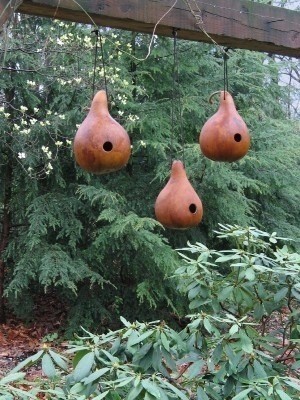
Gourds are fun and easy to grow, and many of the hard-shell types make wonderful houses for common cavity-nesting bird species like chickadees, nuthatches, and martins. Here are some tips on how to grow gourds, cure them, and turn them into cozy homes for your feathered friends.
The Best Gourds for Birdhouses:
The most common types of gourds used for making birdhouses are bottle gourds. In catalogs and garden centers the seeds are often labeled and sold as "Mexican bottle gourds", or "birdhouse" gourds. Other gourds make good birdhouses, too, including: Dipper gourds, Maranka gourds, Penguin gourds, and Kettle gourds. Ideally, the variety you choose should have a bulbous base that is at least 8 to 10 inches in diameter and a neck or stem long enough to attach a wire for hanging.
Growing Gourds:
If you have the room (vines can reach 100 feet in a single season), birdhouse gourds are pretty simple to grow. All they really need is a lot of sun, a lot of water, and a good long stretch (150-180 days) of warm weather. If you live in a cooler climate with a shorter growing season, start seeds early indoors. It's wise to place your seed order in the fall for the following season as supplies of these popular seeds can run short once spring rolls around.
Here is some general information on their growing requirements:
http://www.thriftyfun.com/tf13415917.tip.html
If you don't have the time or room to grow gourds, you can always buy them and do the curing and finishing yourself. Look for them in the fall at nurseries, garden centers, farmer's markets, and crafts stores - the same places you find decorative gourds and pumpkins for sale.
The Curing Process:To cure your gourds, cut them from the vine once they fully mature (turn from green to tan). Store them in a warm location with good air circulation and leave them to dry (up to several months). Don't worry if during the process you see some shriveling and a few small spots appear. This is perfectly normal. When the gourd is completely dry the seeds inside will rattle when you shake it.
Making Birdhouses

Add your voice! Click below to comment. ThriftyFun is powered by your wisdom!
When I make the drainage and vent holes, what size drill bit do I use? Thanks Jeanne
We have a couple of Black Redstart that comes every year and nest in the dustbin location. They have made 4 nests in there and they never use the same nest twice in a row. We clean the oldest nests, that is, we pick up the moss and most of the dirtiest branches that make the structure of the nest and we clean the pipes with just water. Every year they pick up new little branches from the tree and new moss also from the bark of the trees but they also use some parts of the old nests. This bird usually has 3 broods per season but has only one in our place. For the rest of the season we see them coming to get food in our yard at the same rythme as when they feed the new birds. Last year they used a nest in the dustbin location and then a nest in a tree nearby. Knowing this and imagining that they are not the only birds with this need of having a new nest I wonder how you manage to clean the birdhouse. The Black Redstart that come to our house every year are very territorial. There is never a third bird male of female that comes around so I would like to know if you already had different species living next to each other in the birdhouses or couples of the same species and which ones. I would like to put birdhouses around but I know our black and red tails tenants will not admit it.
Add your voice! Click below to comment. ThriftyFun is powered by your wisdom!